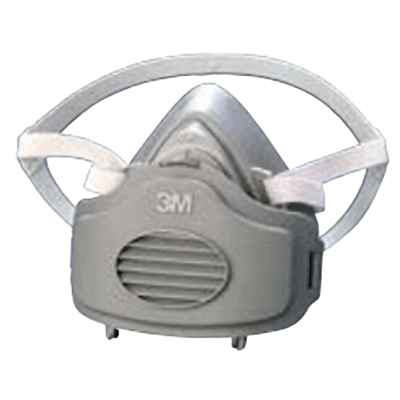What Is a Dust Mask?

A Dust Mask is a mask worn in workplaces where harmful particles such as dust and smoke are present in the air. It refers to a mask that has passed the certification set by the Ministry of Health, Labour and Welfare in the country.
In workplaces where harmful particles, such as dust generated during the demolition of buildings or welding fumes produced during arc welding, are airborne, workers wear masks to protect their health. These masks must have sufficient protective functions to prevent workers from inhaling hazardous substances during their tasks.
The standards for dust masks are divided into three levels based on particle collection efficiency. Additionally, the regulations specify the standard of dust masks that must be used based on the amount of particles present at the worksite.
Uses of Dust Mask
Dust masks are used in workplaces where wearing them is mandatory.
In workplaces where harmful particles are airborne, posing a risk to the health of workers, the use of dust masks is mandated by various laws. Specific workplaces include construction sites, job sites where arc welding is performed, sites where cutting hard materials like rocks takes place, and workplaces involving metal polishing.
In construction and job sites involving metal polishing or cutting hard materials like rocks, fine particles are generated. Since inhaling these particles may have adverse effects on the lungs, the use of dust masks is mandatory.
Arc welding, the process of joining metals by melting them with electric arc discharge, generates a large number of metal particles. The accumulation of these metal particles, known as welding fumes, can lead to health issues such as neurological disorders and cancer if inhaled.
Furthermore, in the demolition of old buildings, there is a risk of asbestos contained in construction materials scattering into the surroundings. Asbestos dust, which disperses finely and easily, can cause health damage such as asbestosis, malignant mesothelioma, and lung cancer when inhaled. For workers handling asbestos, specific classifications for work methods and respiratory protective equipment to be worn are defined for each removal-targeted product.
Principles of Dust Mask
The effectiveness of dust masks in reducing the risk of harmful particles being inhaled into the body is defined by national standards. The standards specify the type of particles used for certification, particle size, and particle filtration efficiency. Additionally, masks are categorized as either disposable (D) or replaceable filters (R).
1. Particles
The particles used for certification are classified as solid particles in the case of sodium chloride (NaCl), labeled as S (Solid), and liquid particles in the case of dioctyl phthalate (DOP), labeled as L (Liquid). The particle size used for certification ranges from 0.06μm to 0.25μm.
2. Particle Filtration Efficiency
Particle filtration efficiency is divided into three levels. Those with a filtration efficiency of 99.9% or higher are categorized as Level 3, those with a filtration efficiency of 99.0% or higher as Level 2, and those with an efficiency of 80.0% or higher as Level 1.
3. Mask
Disposable masks are represented by the symbol D, and replaceable filter masks by the symbol R. Therefore, a mask certified with a 95.5% filtration capacity for solid particles and disposable is denoted as DS2, while a mask certified with a 99.9% filtration capacity for liquid particles and replaceable filter is denoted as RL3.
How to Choose a Dust Mask
When choosing a dust mask, it is essential to prioritize masks that comply with regulations, ensure proper fitting on the worker’s face, and consider potential interference with other protective gear when used in combination.
The selection of the dust mask class depends on factors such as the type and concentration of dust, and it is specified by various laws. After measuring the dust conditions at the work site, it is necessary to choose a mask that complies with these regulations or a higher-class mask.
In arc welding sites, the wearing of protective face shields to shield the eyes from harmful light generated during welding is mandatory. As dust masks are used in conjunction with protective face shields, it is necessary to wear both simultaneously. Similarly, the combination with helmets on construction sites may also be required.
Dust masks are broadly categorized into disposable masks and replaceable filter masks, and within these categories, various types with different shapes, wearing methods, and features such as fan-assisted breathing are commercially available. Considering the factors mentioned above, selecting the most suitable one is crucial.